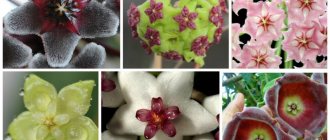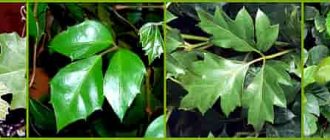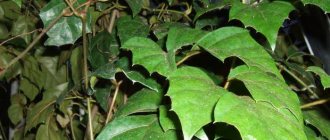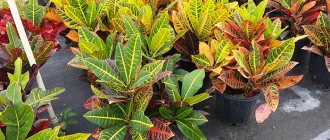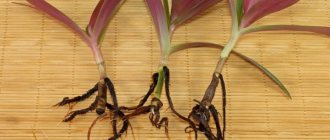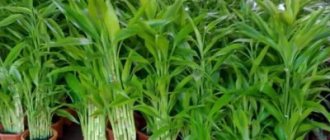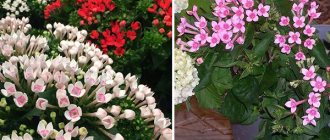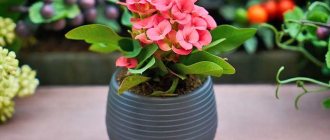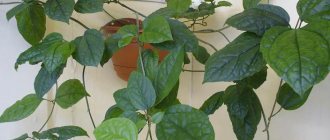The popular houseplant, known to many as lucky bamboo, is similar to wild Asian bamboo only in appearance, but originates from the forests of tropical Africa. The real name of decorative bamboo is Dracaena Sandera, and it belongs to the Asparagus genus. Confusion does not prevent the elegant plant from being successfully cultivated indoors. It does not require special care, and besides, the flower is endowed with the property of attracting prosperity and good luck to the house.
Indistinguishable from bamboo Source images.wemystic.com
What does it look like
Dracaena sandera is a perennial evergreen plant with attractive characteristics:
- The flower has a fleshy segmented stem, with characteristic constrictions reminiscent of bamboo. Initially plastic, over time the stem hardens, especially at the junction of the segments.
One of the varieties of dracaena Source fermer.blog
- The top is crowned with light green, single-color, lanceolate-shaped leaves, glossy in appearance and dense to the touch. Some hybrid varieties have more interesting leaf colors: stripes or with a border around the edge, light or dark.
- When grown indoors, dracaena grows to a height of up to one meter.
Composition of several stems Source www.hortipoint.nl
- Not all varieties bloom at home, and flowering itself occurs rarely and coincides with the warm season. Small white buds are collected in inflorescences.
- The leaves and stems of dracaena are mildly toxic and can cause symptoms of poisoning in a dog or cat that tries them.
Be careful with pets!
Source mothership.sg In specialized stores you can most often find dracaena with a spiral-shaped stem; This is how they represent it: “spiral bamboo.” A barrel twisted into a spiral is not a natural feature; the effect is created artificially.
The stem of a young plant, until it becomes woody, is particularly flexible and pliable. Gardeners have learned to use this property by practicing bending shoots in different ways. After the plants reach a certain age, the auxiliary parts are removed, and the shoot retains its spiral shape.
In Asian style Source deloindom.delo.si
Description
Bamboo, whose height reaches 11 meters, is distinguished by strong branching in its upper part. Bamboo is characterized by rapid growth, up to 0.7 m in height per day and is the fastest growing plant in the world. Spikelets are multi-flowered, arranged in groups and singly on branches with scale-like leaves.
The flowers of the plant are bisexual and wind-pollinated. Ripe grains fall out of the scales and are spread by wind or animals. The above-ground part, after completing its fruiting, completely dies, leaving only the rhizome in a viable state. On average, bamboo in a country house lives for several decades. The duration of the life cycle directly depends on the growing conditions.
How to grow
Due to its appearance, decorative indoor bamboo is an ideal option for home landscaping. It is also recommended to be grown in the winter garden and used in floral arrangements. The flower looks good both individually and in group planting. It is proposed to contain Dracaena in three ways:
- In water. To prevent the stems from starting to rot, pour a little water, a couple of centimeters above the root system. Clean water is suitable for use (chlorinated tap water must be settled), which is changed every 7-10 days. Periodically, the plant is fed with mineral fertilizers (according to the instructions), adding them directly to the water.
In the water Source 2.bp.blogspot.com
- In the ground. Before planting in the ground, bamboo is given time to develop a sufficient root system. The pot should contain not only soil, but also a drainage layer (expanded clay or pebbles are suitable). The soil should be light and dry quickly after watering. A ready-made substrate for dracaenas is ideal, as is a mixture for palm trees or ferns.
Using decor Source www.thespruce.com
- In hydrogel. Bamboo in a clear container filled with colorful hydrogel beads is an acceptable decor for most styles. Hydrogel balls are filled with clean water according to the instructions; The filler is enough for 2-3 years of use. Caring for the plant consists of periodically adding water and fertilizing with mineral fertilizers. If the granules are large, you need to make sure that the roots are not exposed to air.
In hydrogel Source obustroeno.com
See also: Catalog of companies that specialize in designing and performing landscape work of any complexity
Which bamboo to choose
To choose the right specimen for planting in the garden, you need to know the most suitable types of bamboo for a particular region and its characteristics.
The stems reach a height of up to 2.5 m with a stem diameter of 6-7 mm.
The leaves of Sasa are ovate-lanceolate, 12-13 cm long and 4-5 cm wide. The color of the leaves is green above and pale green below. The rhizomes are quite long and thin.
Fargesia
The birthplace of this plant is China. The height of the above-ground part is 4 m.
The trunk is initially dark green. When ripe, the leaf blade takes on an olive-yellow color. Young stems are vertical. Plants can withstand frosts down to -27 degrees and prefer to grow in partial shade. The shoots can be used for food.
Phyllostachys
The stem is erect, 6-21 m high and 9-12 cm in diameter.
The upper part of the leaves is bright green. The wood of the Phyllostachys species is characterized by lightness, hardness and elasticity. The rhizomes are quite long with a high level of viability.
Pleioblastus
Pleioblastus is native to China. Under natural conditions, this species grows up to 7-8 m.
with a stem diameter of up to 3 cm. The shoots are erect and highly branched. The length of the internodes is 43-45 cm. The nodes are protruding type. The shoots are well leafy. The leaf blade is lanceolate in shape with a length of 8 to 30 cm. It has average requirements for the presence of moisture.
Principles of care
Bamboo is not particularly picky and adapts to a fairly wide temperature range. The plant does well in temperatures between 18 and 35°C, but should not be placed in front of an air conditioner or vent. When breeding dracaena, it is useful to adhere to the following maintenance recommendations:
- Lighting. Decorative bamboo, native to shady tropical forests, does not like direct sun, so it is not left on the windowsill for a long time. At the same time, the place should be sufficiently illuminated, possibly with the help of artificial lighting.
In the interior of the kitchen Source attuale.ru
- Humidity. Dracaena Sandera is not picky about humidity levels; she is quite happy with the air of modern apartments. If the atmosphere is too dry, it is recommended to wipe the leaves from time to time with a damp cloth and spray them periodically.
Spraying Source www.rd.com
- Watering. The best option would be to use soft water (for example, melt water), but settled water is also suitable. The plant does not respond well to drought, so you need to carefully monitor the soil moisture or water level. On average, water is added (or changed) once a week.
Bamboo needs quality water Source cf.ltkcdn.net
- Feeding. In stores it is often customary to overuse fertilizers, so after purchasing bamboo you should wait 1-2 months before starting fertilizing. All additives are added according to the recommendations; for dracaena in water, the dosage is reduced.
Plants ready to plant Source iorigen.com
- Trimming. It is necessary so that the flower does not lose its decorative effect by stretching beyond measure. The bamboo is simply shortened to the desired height, and a new plant is sprouted from the cut top.
Section processed after trimming Source ogorod-bez-hlopot.ru
- Transfer. It is carried out once every two to three years for ground plants. In order not to damage the delicate roots, a gentle method is used - transshipment.
Root system Source archidea.com.ua
- Reproduction. At home, the easiest way is to use cuttings, in which the apical shoots (cuttings) are cut off, and the cut site is treated with crushed coal or wax. The cuttings are placed in water; They can be planted in the ground after the roots have sprouted. On the mother stem, shoots will also begin to sprout from the buds under the cut site.
Propagation by cuttings Source www.iphones.ru
Diseases and pests
Bamboo is quite resistant to most diseases and dangerous pests. The exceptions are spider mites and mealybugs. According to the recommendations, when a tick is detected, it is treated with acaricidal preparations, and when a mealybug appears, the insecticide Karbofos is used.
What to do if bamboo turns yellow
Many gardeners wonder why bamboo turns yellow. First of all, remember that some types of plants dry out in the fall for natural reasons according to the duration of their life cycle.
But there are other reasons that can cause yellowing leaves. Most often, yellowed bamboo is due to waterlogging of the roots, lack of nutrients, salinization of the soil, or infection of the plant. It is best to fight the infection with drugs such as Strobi or Falcon. For other reasons, feed and water the bamboo in a timely manner and in the right amount.
How to twist a spiral
Intertwined and spiral-twisted bamboo stems are in high demand. Making a plant bend in the right way is difficult and painstaking work. It takes gardeners months of daily labor to shape and curve a bamboo plant beautifully.
How to bend bamboo Source bronx120.org
The formation of the trunk begins after a strong root system has formed. One way is to place the sprout in a curved tube. The gardener monitors the growth by controlling the size of the stem. When the desired form is obtained, the plant is released from captivity.
Regular and molded bamboo Source www.jornalahora.com
The stems always grow towards the sun. This law serves as a key operating element in another common forming method. In Asian countries, growing on its side is practiced. The flower is placed in a box open on one side; it must be rotated relative to the light, observing regularity. Theoretically, this process can be reproduced at home.
Decor for every taste Source 4.bp.blogspot.com
Growing at home with limited access to light is a time-consuming task that can take more than one month. You can grow decorative bamboo at home in a simplified way, using young stems that have not yet hardened. To do this, the plastic stem is fixed on a support of the desired shape using thin wire and tape. When the bamboo stem is completely lignified, the support is carefully removed.
In an eco-interior Source raw.cdn.baca.co.id
